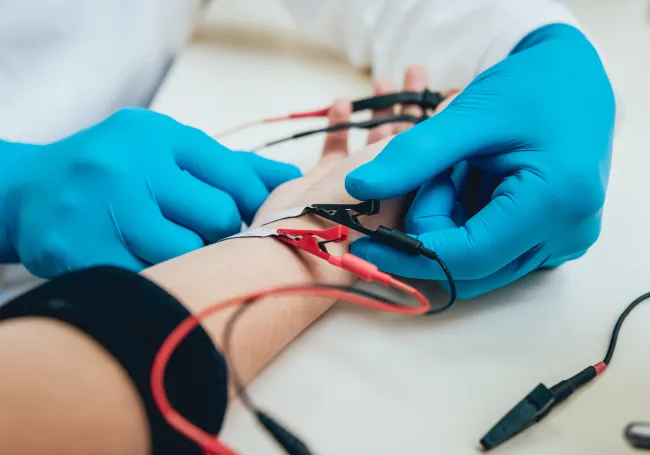Electromyography (EMG) and nerve conduction studies (NCS) are tests that measure the electrical activity of muscles and nerves. Nerves send out electrical signals to make your muscles react in certain ways. As your muscles react, they give off these signals, which can then be measured.
- An EMG test looks at the electrical signals your muscles make when they are at rest and when they are being used.
- A nerve conduction study measures how fast and how well the body's electrical signals travel down your nerves.

What are they used for?
EMG tests and nerve conduction studies can both help find out if you have a disorder of your muscles, nerves, or both. These tests can be done separately, but they are usually done at the same time.
They help diagnose a variety of muscle and nerve disorders. An EMG test helps find out if muscles are responding the right way to nerve signals. Nerve conduction studies help diagnose nerve damage or disease. When EMG tests and nerve conduction studies are done together, it helps providers tell if your symptoms are caused by a muscle disorder or a nerve problem.
Why do I need an EMG test and a nerve conduction study?
You may need these tests if you have symptoms of a muscle or nerve disorder. These symptoms include:
- Muscle weakness
- Tingling or numbness in arms, legs, hands, feet, and/or face
- Muscle cramps, spasms, and/or twitching
- Paralysis of any muscles
Abnormal test results can indicate a variety of different conditions. Depending on which muscles or nerves are affected, it may mean one of the following:
- Carpal tunnel syndrome, a condition that affects nerves in the hand and arm. It's usually not serious, but can be painful.
- Herniated disc, a condition that happens when a part of your spine, called a disc, is damaged. This puts pressure on the spine, causing pain and numbness
- Guillain-Barré syndrome, an autoimmune disorder that affects the nerves. It can lead to numbness, tingling, and paralysis. Most people recover from the disorder after treatment
- Myasthenia gravis, a rare disorder that causes muscle fatigue and weakness.
- Muscular dystrophy, an inherited disease that seriously affects muscle structure and function.
- Charcot-Marie-Tooth disease, an inherited disorder that causes nerve damage, mostly in the arms and legs.
- Amyotrophic lateral sclerosis (ALS), also known as Lou Gehrig's disease. This is a progressive, ultimately fatal, disorder that attacks nerve cells in your brain and spinal cord. It affects all the muscles you use to move, speak, eat, and breathe.
Preparation
Tell your health care provider if you have a pacemaker or cardiac defibrillator. Special steps will need to be taken before the test if you have one of these devices.
Make sure your skin is clean. Don't use lotions, creams, or perfumes for a day or two before the test.
Wear loose, comfortable clothing that allows easy access to the test area or can be easily removed if you need to change into a hospital gown.
What to expect during test
For an EMG test:
- You will sit or lie down on a table or bed.
- Your provider will clean the skin over the muscle being tested.
- Your provider will place a needle electrode into the muscle. You may have slight pain or discomfort when the electrode is inserted.
- The machine will record the muscle activity while your muscle is at rest.
- Then you will be asked to tighten (contract) the muscle slowly and steadily.
- The electrode may be moved to record activity in different muscles.
- The electrical activity is recorded and shown on a video screen. The activity is displayed as wavy and spiky lines. The activity may also be recorded and sent to an audio speaker. You may hear popping sounds when you contract your muscle.
For a nerve conduction study:
- You will sit or lie down on a table or bed.
- Your provider will attach one or more electrodes to a certain nerve or nerves using tape or a paste. The electrodes, called stimulating electrodes, deliver a mild electrical pulse.
- Your provider will attach different types of electrodes to the muscle or muscles controlled by those nerves. These electrodes will record the responses to the electrical stimulation from the nerve.
- Your provider will send a small pulse of electricity through the stimulating electrodes to stimulate the nerve to send a signal to the muscle.
- This may cause a mild tingling feeling.
- Your provider will record the time it takes for your muscle to respond to the nerve signal.
- The speed of the response is called the conduction velocity.
If you are having both tests, the nerve conduction study will be done first.
How EMG & NCS Tests Work
This video explains electromyography and nerve conduction studies, and what to expect during your test.
